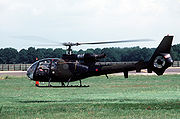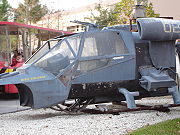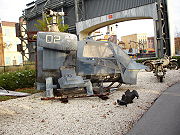
Blue Thunder (helicopter)
Encyclopedia
Blue Thunder is the title character
Blue Thunder
Blue Thunder is a 1983 feature film that features a high-tech helicopter of the same name. The movie was directed by John Badham and stars Roy Scheider...
in the 1980s American
United States
The United States of America is a federal constitutional republic comprising fifty states and a federal district...
film
Blue Thunder
Blue Thunder is a 1983 feature film that features a high-tech helicopter of the same name. The movie was directed by John Badham and stars Roy Scheider...
and television series
Blue Thunder (TV series)
Blue Thunder is a 1984 ABC TV series based on the movie of the same title featuring the Blue Thunder helicopter.The series used the converted Aérospatiale Gazelle helicopter and large portions of stock footage from the 1983 film. A ground unit named "Rolling Thunder" backed up the helicopter in...
of the same name. The aircraft itself was a converted Aérospatiale Gazelle
Aérospatiale Gazelle
The Aérospatiale Gazelle is a five-seat light helicopter, powered by a single turbine engine. It was designed and manufactured in France by Sud Aviation . It was also manufactured under licence by Westland Aircraft in the United Kingdom , by SOKO in Yugoslavia and ABHCO in Egypt...
helicopter.
Aérospatiale Gazelle

Aérospatiale
Aérospatiale was a French aerospace manufacturer that built both civilian and military aircraft, rockets and satellites. It was originally known as Société Nationale Industrielle Aérospatiale...
SA-341G Gazelle
Aérospatiale Gazelle
The Aérospatiale Gazelle is a five-seat light helicopter, powered by a single turbine engine. It was designed and manufactured in France by Sud Aviation . It was also manufactured under licence by Westland Aircraft in the United Kingdom , by SOKO in Yugoslavia and ABHCO in Egypt...
. Blue Thunder used two SA-341Gs, serial numbers 1066 and 1075, that were both produced in 1973. After the film was made, both helicopters were sold to Michael E. Grube, an aviation salvage collector in Clovis, New Mexico. Grube then leased s/n 1066 (ex-) to a film company that was shooting Amerika
Amerika (TV miniseries)
Amerika – suggesting a Russified name for the United States – is an American television miniseries that was broadcast in 1987 on ABC. It starred Kris Kristofferson, Mariel Hemingway, Sam Neill, Robert Urich, and a 17-year-old Lara Flynn Boyle in her first major role. Amerika was about life in the...
, an ABC
American Broadcasting Company
The American Broadcasting Company is an American commercial broadcasting television network. Created in 1943 from the former NBC Blue radio network, ABC is owned by The Walt Disney Company and is part of Disney-ABC Television Group. Its first broadcast on television was in 1948...
television mini-series
Miniseries
A miniseries , in a serial storytelling medium, is a television show production which tells a story in a limited number of episodes. The exact number is open to interpretation; however, they are usually limited to fewer than a whole season. The term "miniseries" is generally a North American term...
about Soviet occupation of the USA; the helicopters were painted black, and the surveillance microphones were removed. After Grube got it back, it was dismantled and sold for parts.
The second, s/n 1075 (ex-), was scrapped during 1988. There was a third static display model built for close-up shots with the actors.
Blue Thunder helicopter

Canopy (aircraft)
An aircraft canopy is the transparent enclosure over the cockpit of some types of aircraft. The function of the canopy is to provide a weatherproof and reasonably quiet environment for the aircraft's occupants. The canopy will be as aerodynamically shaped as possible to minimize drag.-History:Very...
patterned after the AH-64 Apache
AH-64 Apache
The Boeing AH-64 Apache is a four-blade, twin-engine attack helicopter with a tailwheel-type landing gear arrangement, and a tandem cockpit for a two-man crew. The Apache was developed as Model 77 by Hughes Helicopters for the United States Army's Advanced Attack Helicopter program to replace the...
. Two helicopters were used in the filming of the movie, one for the actual stunts (a "stunt mule"), one as a backup in case the other was grounded for maintenance. Stunts were flown by Jim Gavin.
The helicopters were purchased by Columbia Pictures and flown to Cinema Air in Carlsbad, California, where they were heavily modified for the film. These alterations made the helicopters so heavy that various tricks had to be employed to make it look fast and agile in the film. For instance, the 360° loop maneuver at the end of the film was carried out by a 1/6-scale radio control
Radio control
Radio control is the use of radio signals to remotely control a device. The term is used frequently to refer to the control of model vehicles from a hand-held radio transmitter...
led model. (This aircraft was built and flown by modeller and RC helicopter manufacturer John Simone Jr.)
Film description
Described in the film as having 1 in (25.4 mm) "no-lock metal armor", Blue Thunder had a chin turret with an "electric" 20 mm (0.78740157480315 in) six-barrel Gatling gunGatling gun
The Gatling gun is one of the best known early rapid-fire weapons and a forerunner of the modern machine gun. It is well known for its use by the Union forces during the American Civil War in the 1860s, which was the first time it was employed in combat...
able to deliver 4,000 rounds per minute. Surveillance used twin cheek-mounted Nitesun spotlights, infrared thermograph, and airborne TV camera with 100:1 zoom and night-vision capability. The cameras fed 3/4 in videotape
Videotape
A videotape is a recording of images and sounds on to magnetic tape as opposed to film stock or random access digital media. Videotapes are also used for storing scientific or medical data, such as the data produced by an electrocardiogram...
, with a locker in the belly of the aircraft. External audio pickups were capable of hearing "a mouse fart at two thousand feet". A "whisper mode" granted her the ability to operate in silence. (They resembled sound absorbers used on Jolly Greens in Vietnam.)
Blue Thunders cannon was controlled by a Harrison helmet in conjunction with a "Harrison Fire Control System" (which is named after one of the special effects prop designers and not an existing fire control system). The project cost was described as US$5 million.
Specifications


Blue Thunder v. Gazelle
| Gazelle | Blue Thunder | |
|---|---|---|
| Crew | 2 (pilot & copilot) | 2 (pilot & weapons technician) |
| Passengers | 5–6 | 1-2 (non-crew may use the copilot seat and/or a seat behind the technician's seat) |
| Length | 49.54 ft (15.1 m) | |
| Height | 11.68 ft (3.56 m) | |
| Weight | 4,555 lb (2,066 kg) | unspecified |
| Speed | 149 mph (240 km/h) | |
| Range | 373 mi (600 km) | |
| Ceiling | 12,800 ft (3,901 m) | |
| Power (x2) | 618 hp (461 kW) | unspecified |
Miscellaneous equipment
- The helmet-controlled gun turret and Target Acquisition and Designation System (TADS) was inspired by the AH-64 ApacheAH-64 ApacheThe Boeing AH-64 Apache is a four-blade, twin-engine attack helicopter with a tailwheel-type landing gear arrangement, and a tandem cockpit for a two-man crew. The Apache was developed as Model 77 by Hughes Helicopters for the United States Army's Advanced Attack Helicopter program to replace the...
, which uses an "Integrated Helmet And Display Sight System" (IHADSS), wherein the nose-mounted sensors and the 30 mm chain gunM230 Chain GunThe Hughes M230 Chain Gun is a 30 mm, single-barrel automatic cannon developed by Hughes and now manufactured by Alliant Techsystems. It is an electrically operated chain gun, a weapon that uses external power instead of recoil to load its rounds....
are linked to the gunner's helmet. - The bolt-on cockpit of the original helicopter used to be visible on the backlot tour of MGM Studios in Florida. It has not been present in the 'bone yard' since at least 2005.

